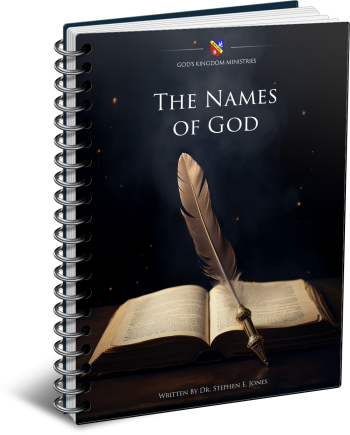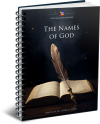Latest Posts
View the latest posts in an easy-to-read list format, with filtering options.

God has revealed His primary name as Jehovah (or Yahweh). But there are 12 variations of Jehovah that reveal specific aspects of His nature so that we can get to know Him.
Category - General

The last verse in Ezekiel gives us the name Jehovah-Shammah, “The Lord is there.” After the prophet wrote about the dimensions of the New Jerusalem and its temple, Ezekiel 48:35 ends with this:
35 The city shall be 18,000 cubits round about; and the name of the city from that day shall be, “The Lord is there” [Jehovah-Shammah].
In Ezekiel’s time, most people undoubtedly viewed the dimensions of the temple according to an Old Covenant mindset that was prevalent at the time. Hence, they would have seen this description as an enlarged city built upon the ruins of the original city that had been destroyed by the Babylonians.
We, however, have the benefit of a New Covenant perspective. In particular, we have John’s description of the New Jerusalem in Revelation 21 that is not intended to be taken literally, for it is a heavenly city whose dimensions are not literal but symbolic.
There are also some differences between Solomon’s temple and Ezekiel’s temple. Both give the measure of the sanctuary as 60 x 20 cubits, but Solomon’s temple was measured “according to the old standard” (2 Chron. 3:3), that is, the ordinary cubit of 19.8 inches. Ezekiel’s temple, however, used “long cubits” (Ezekiel 41:8), each being one handbreadth longer than the old standard cubit (Ezekiel 43:13). The long cubit measured 23.1 inches.
Solomon’s temple was 60 x 20 cubits, so its perimeter was 160 cubits, or 3168 inches in length (60 x 2 plus 20 x 2). The number 3168 represents the Lord Jesus Christ. Lord (kurios) has a numeric value of 800; Jesus (Iesus) has a numeric value of 888; and Christ (christos) has a numeric value of 1480. If you add them together, you get 3168, the perimeter that defines the dimension of Solomon’s temple. His temple was designed to represent the Lord Jesus Christ.
It is not likely that Solomon himself understood this, because he was probably unfamiliar with the Greek language. Neither did he know that the gospel a thousand years later would come down to us in Greek. But God, who revealed the “pattern” (blueprint) of the temple to David (1 Chron. 28:12, KJV), knew the end from the beginning.
Ezekiel’s temple was measured by “a man whose appearance was like the appearance of bronze” (Ezekiel 40:3). He used “a measuring rod of six cubits” (Ezekiel 40:5). A reed measured six long cubits or seven cubits using the old standard cubit.
The Holy Place measured 40 x 20 cubits (Ezekiel 41:2), and the Most Holy Place was 20 x 20 cubits. In other words, Ezekiel’s sanctuary was 60 x 20 cubits, but by using the long cubit, its perimeter of 160 cubits measured 3,696 inches. Hence, the perimeter of Ezekiel’s temple was 528 inches longer than the perimeter of Solomon’s temple.
The Hebrew word maftayach means “key” and is used of the key of David in Isaiah 22:22. It has a numeric value of 528. Hence, the difference between the two temples is the key of David. The number 528 is also a powerful healing frequency, and this may be why the heavenly Jerusalem’s street contains a tree whose leaves are for the healing of the nations (Rev. 22:2).
The perimeter of Ezekiel’s city is said to be 18,000 cubits (Ezekiel 48:35). Using the long cubit of 23.9 inches each, this would be 430,200 inches. The measure of the perimeter of the New Jerusalem in Rev. 21:16 is 12,000 furlongs (stadion, about 202 yards each). This would be 87,264,000 inches, which is nearly 203 times greater than Ezekiel’s city. Note the progression in size from Solomon’s temple to Ezekiel’s temple to the temple that John saw in Revelation 21.
Fortunately, we do not have to choose which account to believe, because all of these are symbolic of a spiritual city that is increasing in size. Both Paul and John refer to the New Jerusalem as a heavenly city. Ezekiel’s city of 18,000 cubits (perimeter) emphasizes the number 18 (“oppression, bondage”), while John’s city connects it to the chosen ones who are its rulers. Twelve is the biblical number of governmental perfection. The Greek word eklogay (“elect, chosen”) has a numeric value of 144 (or 12 x 12). This is also the numeric value of Lazarus which points to the resurrected ones.
Hence, it seems that Ezekiel’s city, defined according to its 18,000 cubit perimeter, seems to point to the earthly Jerusalem that is in bondage with her children (Gal. 4:24, KJV), whereas John’s city is the heavenly Jerusalem which “is free” (Gal. 4:26).
There are two cities that go by the same name: Jerusalem. The Old Testament writings do not distinguish them, except that the name of the city literally means two Jerusalems. The Hebrew name, Yeru-shalayim has the dual ending “ayim.” The Hebrew language has duals (ayim, “two”) and plurals (im, “three or more”).
The ancient rabbis discussed this and wondered why Jerusalem was a dual. No doubt Paul had participated in such discussions while he was a student under Gamaliel. He later came to the conclusion that there were indeed two cities, writing in Gal. 4:25, 26,
25 Now this Hagar is Mount Sinai in Arabia and corresponds to the present Jerusalem, for she is in slavery with her children. 26 But the Jerusalem above is free; she is our mother.
The Old Testament prophets, as we said earlier, never attempt to distinguish between the two cities. Sometimes Jerusalem means the earthly city and at other times, it is the heavenly city. As a general rule, whenever the prophets speak of an imperfect, sinful, or lawless Jerusalem, they spoke of the earthly city. When they spoke about Jerusalem in glorious terms, they were referring to the heavenly city.
Speaking of the earthly Jerusalem, Ezekiel 24:9 says, “Woe to the bloody city!” Nahum 3:1 echoes the same sentiment, saying, “Woe to the bloody city, completely full of lies and pillage.”
Yet of the heavenly city, Zech. 14:11 says, “People will live in it, and there will no longer be a curse, for Jerusalem will dwell in security.” Isaiah goes further, linking Jerusalem to the new heavens and the new earth, implying that this is also the New Jerusalem. Isaiah 65:17, 18 says,
17 For behold, I create new heavens and a new earth; and the former things will not be remembered or come to mind. 18 But be glad and rejoice forever in what I create; for behold, I create Jerusalem for rejoicing and her people for gladness.
The earthly Jerusalem had existed for thousands of years, but Isaiah saw a city that was either in the process of being created or was to be created in the future. His city was revealed in the last half of Isaiah, which was the prophet’s revelation of New Covenant conditions yet to come. So it is clear that the prophet was speaking of the New Jerusalem and not the old city.
For this reason, too, when John describes the heavenly city, he quotes from Zechariah and Isaiah, using their prophecies about “Jerusalem.” In other words, John interprets “Jerusalem” as Old Testament prophecies of the “New Jerusalem” (Rev. 21:2). Paul then makes a clear distinction between the two cities in Gal. 4:24, 25.
The point is that the name of the city, revealed in Ezekiel 48:35 as Jehovah-Shammah, is not the old city but the new. God’s presence is no longer in a temple in the earthly Jerusalem, but in the heavenly city which Abraham sought for as an “alien” during his sojourn in Canaan (Heb. 11:9). We too, as the household of Abrahamic faith, are also aliens insofar as the old city is concerned, “having confessed that they were strangers and exiles on the earth” (Heb. 11:13).
To invoke the name of Jehovah-Shammah is to appeal for recognition as a citizen of the heavenly Jerusalem. New Covenant believers are living stones in the temple that the Spirit of God now inhabits. Secondly, we may claim benefits that come with our citizenship. Being a citizen of the heavenly city is what makes us, “like Isaac… children of promise.” What does that mean?
Paul says in Philippians 3:20, 21,
20 For our citizenship is in heaven, from which also we eagerly wait for a Savior, the Lord Jesus Christ; 21 who will transform the body of our humble state into conformity with the body of His glory, by the exertion of the power that He has even to subject all things to Himself.
Citizenship in the city called Jehovah-Shammah gives us the hope of being transformed into the image of Christ. This is because “Jehovah is there.” He is present in this heavenly City that is named after Him. By implication, He is NOT present in the earthly Jerusalem, for He forsook that city even as He departed in earlier times from Shiloh (Jer. 7:12-14).
Recall that Shiloh was named prophetically, Ichabod, “the glory has departed” (1 Sam. 4:21, 22). It denotes a town where God’s presence has departed—never to return. He is no longer “there.” Those who consider Hagar-Jerusalem to be their spiritual “mother” may be in danger of being “cast out” along with their mother (Gal. 4:30).
But we are not the children of the earthly Jerusalem. We are children of the city called prophetically Jehovah-Shammah. As children (citizens) of this city, we have the right to expect to be transformed into the image of its King.